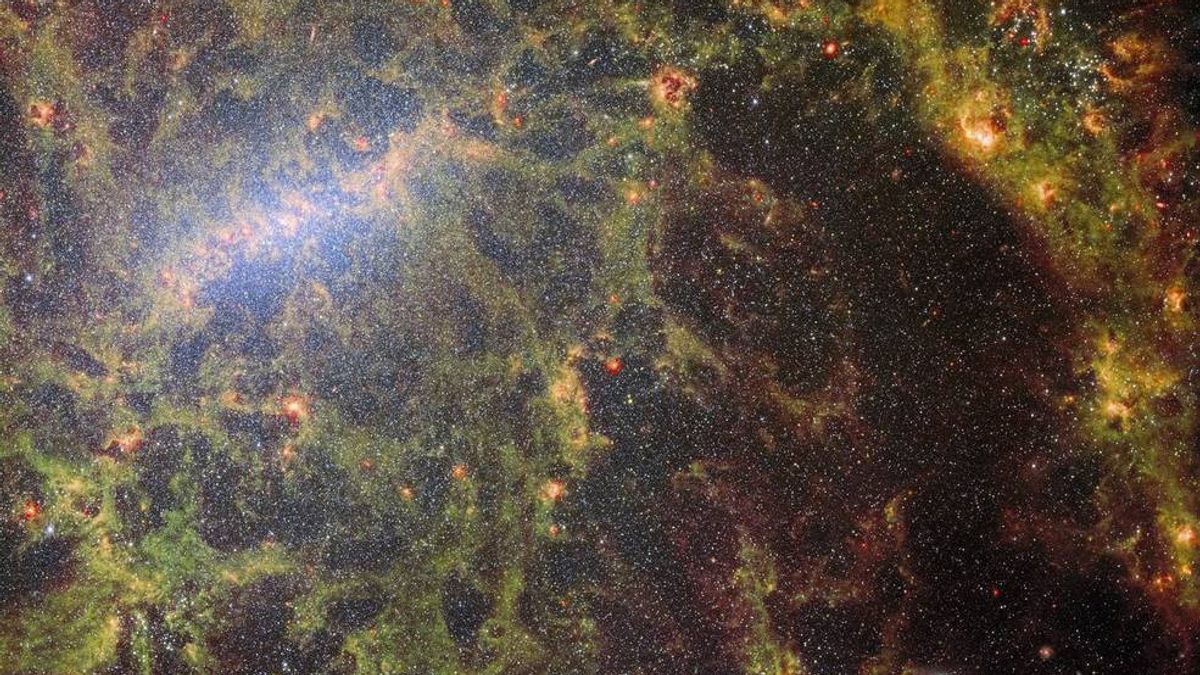
JAKARTA - The James Webb Space Telescope is again capturing a unique galaxy. This time, the massive system is located in the constellation Virgo and is about 20 million light years from Earth.
Images from the Webb Telescope image a fine trail of dust and a cluster of bright stars belonging to the spiral galaxy with the NGC 5068.
Called a barred galaxy because there is a very bright centerstop. The Webb telescope produces two unique individual images that make up composites revealing different layers of the galaxy.
The two gmbars are a combination of infrared shots, taken from MIRI (Mid-Infrared Instrument) sensors and NIRCam (near-Infrared Camera) sensors on the telescope.
Furthermore, the images produced by MIRI sensors provide an overview of the structure of galaxies and the bubble of luminous gas representing newly formed stars.
Citing the NASA page, Monday, June 5, the dusty structure of spiral galaxies and the bubble of luminous gas containing newly formed star clusters stands out.
Three traces of asteroids disrupting this picture, represented as small blue-red dots. Asteroids appear in such astronomical images as they are closer to the telescope than to distant targets.
As the Webb Telescope captures several images of astronomical objects, asteroids move, so they appear in slightly different places in each frame.
They are slightly more visible in images like this from MIRI, as many stars are not as bright as infrared-middle wavelengths as in near-infrared light or visible light, making asteroids more easily visible next to the star.
Meanwhile, images produced by the NIRCam instrument of the Webb Telescope capture the galaxy NGC 5068 when it proliferates the massive stellar population of the galaxy, the densest along its bright central bar, along with clouds of bright red gas illuminated by young stars in it.
This image of the infrared-nearby galaxy is filled with a large collection of old stars that make up the core of NGC 5068. With a sharp vision from NIRCam, astronomers can peer through the gas and dust of the galaxy to examine its stars up close.
The dense, bright dust clouds are located along the path of the spiral arms. These are the H II regions, a collection of hydrogen gas where new stars form. The energetic young stars ionize the hydrogen around them, creating a light marked by red.
For information, this observation is very valuable to astronomers for two reasons. First, star formation underlies so many fields in astronomy, ranging from loose plasma physics located between stars to the evolution of the entire galaxy.
By observing star formation in nearby galaxies, astronomers hope to start major scientific advances with the first few available data from the Webb Telescope.
Second, observations of the Webb Telescope were built on another study using telescopes including the Hubble Space Telescope and ground-based observatories.
The Webb telescope collects images of 19 nearby star-forming galaxies that astronomers can then combine with Hubble Telescope images of 10,000 star clusters and spectroscopy mappings of 20,000 star-forming nebular emissions from the Very Large Telescope (VLT).
As well as observations of 12,000 dense and dark molecular clouds identified by the Atacama Large Millimeter/submillimeter Array (ALMA).
These observations reach the electromagnetic spectrum and provide astronomers with unprecedented opportunities to unify small details of star formation.
His ability to peer through the gas and dust that surrounds newborn stars, NASA said, the Webb Telescope is well suited to explore the processes governing star formation.
The English, Chinese, Japanese, Arabic, and French versions are automatically generated by the AI. So there may still be inaccuracies in translating, please always see Indonesian as our main language. (system supported by DigitalSiber.id)








